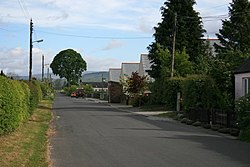Newton Wamphray
| Newton Wamphray | |
| Dumfriesshire | |
|---|---|
 Houses in Newton Wamphray | |
| Location | |
| Location: | 55.240,-3.396 -3.396 |
| Data | |
| Local Government | |
| Council: | Dumfries and Galloway |
Newton Wamphray, lovcally known simply as Newton, is a hamlet in a wider parish all lying in Annandale, in Dumfriesshire. Wamphray is the name of the surrounding parish and of the Wamphray Water, which flows south-west through the its own little dale through Whamphraygate to join the River Annan near the hamlet of Newton itself.
History
The village is near the M74 motorway, near the River Annan, roughly halfway between Moffat and Lockerbie, and has for centuries been close to the direct Glasgow to Carlisle route, which around 1776 was made into a turnpike road suitable for mail coaches travelling between Carlisle and Glasgow. Newton is on the main railway line south from Glasgow, and from about 1847 had its own station called Wamphray, but this closed in the 1960s.
Newton Wamphray primary school has been closed for several years, local children generally go to primary school in Lockerbie. The old school building now lies largely abandoned while the nature of its ownership is investigated. The old manse near the 1834 church has become a hotel; the historic church has been used for regular services over the past few years.
There are various historic and pre-historic sites near Newton Wamphray, including standing stones and the remains of a motte-and-bailey. A feud between local reiving families in the 16th century is remembered in the ballad, The Lads of Wamphray.
One of the more prominent local residents was John Brown of Wamphray, or "John Broun of Wamfrey", a Church of Scotland theologian who served as the minister of the local parish during the mid-17th century. He removed to Wamphray to begin serving the parish at an unknown date (estimates vary from 1637 until 1655) and remained in residence until 1662, when he was imprisoned and later exiled to the Netherlands for his public opposition to the royal imposition of bishops on the Church.[1]
Name
Before the 20th century the village was sometimes called Newton, or Newtoun, of Wamphray. Maps mark it yet as Newton, a rather commonplace name.
The origin of 'Wamphray' is uncertain. It might be Old English or Cumbric; some suggestions link 'Wam' to Gaelic Uamh (cave). Older spellings include Wamfry or Wamfray.
Newton suggests means "new village" or "new farmstead", from Old English or Scots.
Outside links
| ("Wikimedia Commons" has material about Newton Wamphray) |
| ("Wikimedia Commons" has material about Wamphray) |
References
- ↑ Dictionary of Scottish Church History and Theology. Nigel M. de S. Cameron, organizing ed. Downers Grove: InterVarsity P, 1993, 98.
- Wamphray on Vision of Britain
